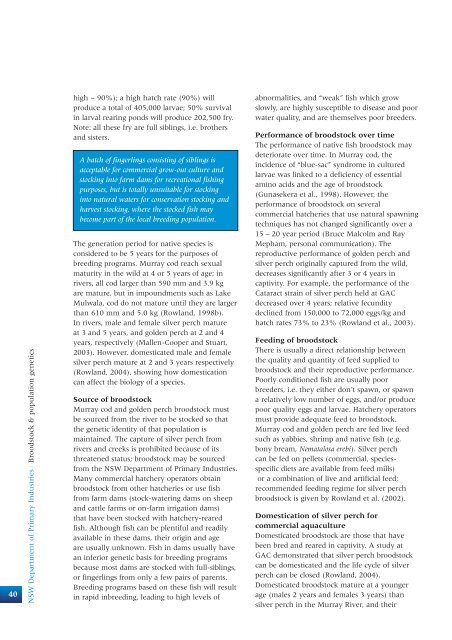Hatchery Quality Assurance Program - NSW Department of Primary ...
Hatchery Quality Assurance Program - NSW Department of Primary ...
Hatchery Quality Assurance Program - NSW Department of Primary ...
Create successful ePaper yourself
Turn your PDF publications into a flip-book with our unique Google optimized e-Paper software.
40<br />
<strong>NSW</strong> <strong>Department</strong> <strong>of</strong> <strong>Primary</strong> Industries | Broodstock & population genetics<br />
high ~ 90%); a high hatch rate (90%) will<br />
produce a total <strong>of</strong> 405,000 larvae; 50% survival<br />
in larval rearing ponds will produce 202,500 fry.<br />
Note: all these fry are full siblings, i.e. brothers<br />
and sisters.<br />
A batch <strong>of</strong> fingerlings consisting <strong>of</strong> siblings is<br />
acceptable for commercial grow-out culture and<br />
stocking into farm dams for recreational fishing<br />
purposes, but is totally unsuitable for stocking<br />
into natural waters for conservation stocking and<br />
harvest stocking, where the stocked fish may<br />
become part <strong>of</strong> the local breeding population.<br />
The generation period for native species is<br />
considered to be 5 years for the purposes <strong>of</strong><br />
breeding programs. Murray cod reach sexual<br />
maturity in the wild at 4 or 5 years <strong>of</strong> age; in<br />
rivers, all cod larger than 590 mm and 3.9 kg<br />
are mature, but in impoundments such as Lake<br />
Mulwala, cod do not mature until they are larger<br />
than 610 mm and 5.0 kg (Rowland, 1998b).<br />
In rivers, male and female silver perch mature<br />
at 3 and 5 years, and golden perch at 2 and 4<br />
years, respectively (Mallen-Cooper and Stuart,<br />
2003). However, domesticated male and female<br />
silver perch mature at 2 and 3 years respectively<br />
(Rowland, 2004), showing how domestication<br />
can affect the biology <strong>of</strong> a species.<br />
Source <strong>of</strong> broodstock<br />
Murray cod and golden perch broodstock must<br />
be sourced from the river to be stocked so that<br />
the genetic identity <strong>of</strong> that population is<br />
maintained. The capture <strong>of</strong> silver perch from<br />
rivers and creeks is prohibited because <strong>of</strong> its<br />
threatened status; broodstock may be sourced<br />
from the <strong>NSW</strong> <strong>Department</strong> <strong>of</strong> <strong>Primary</strong> Industries.<br />
Many commercial hatchery operators obtain<br />
broodstock from other hatcheries or use fish<br />
from farm dams (stock-watering dams on sheep<br />
and cattle farms or on-farm irrigation dams)<br />
that have been stocked with hatchery-reared<br />
fish. Although fish can be plentiful and readily<br />
available in these dams, their origin and age<br />
are usually unknown. Fish in dams usually have<br />
an inferior genetic basis for breeding programs<br />
because most dams are stocked with full-siblings,<br />
or fingerlings from only a few pairs <strong>of</strong> parents.<br />
Breeding programs based on these fish will result<br />
in rapid inbreeding, leading to high levels <strong>of</strong><br />
abnormalities, and “weak” fish which grow<br />
slowly, are highly susceptible to disease and poor<br />
water quality, and are themselves poor breeders.<br />
Performance <strong>of</strong> broodstock over time<br />
The performance <strong>of</strong> native fish broodstock may<br />
deteriorate over time. In Murray cod, the<br />
incidence <strong>of</strong> “blue-sac” syndrome in cultured<br />
larvae was linked to a deficiency <strong>of</strong> essential<br />
amino acids and the age <strong>of</strong> broodstock<br />
(Gunasekera et al., 1998). However, the<br />
performance <strong>of</strong> broodstock on several<br />
commercial hatcheries that use natural spawning<br />
techniques has not changed significantly over a<br />
15 – 20 year period (Bruce Malcolm and Ray<br />
Mepham, personal communication). The<br />
reproductive performance <strong>of</strong> golden perch and<br />
silver perch originally captured from the wild,<br />
decreases significantly after 3 or 4 years in<br />
captivity. For example, the performance <strong>of</strong> the<br />
Cataract strain <strong>of</strong> silver perch held at GAC<br />
decreased over 4 years; relative fecundity<br />
declined from 150,000 to 72,000 eggs/kg and<br />
hatch rates 73% to 23% (Rowland et al., 2003).<br />
Feeding <strong>of</strong> broodstock<br />
There is usually a direct relationship between<br />
the quality and quantity <strong>of</strong> feed supplied to<br />
broodstock and their reproductive performance.<br />
Poorly conditioned fish are usually poor<br />
breeders, i.e. they either don’t spawn, or spawn<br />
a relatively low number <strong>of</strong> eggs, and/or produce<br />
poor quality eggs and larvae. <strong>Hatchery</strong> operators<br />
must provide adequate feed to broodstock.<br />
Murray cod and golden perch are fed live feed<br />
such as yabbies, shrimp and native fish (e.g.<br />
bony bream, Nematalosa erebi). Silver perch<br />
can be fed on pellets (commercial, speciesspecific<br />
diets are available from feed mills)<br />
or a combination <strong>of</strong> live and artificial feed;<br />
recommended feeding regime for silver perch<br />
broodstock is given by Rowland et al. (2002).<br />
Domestication <strong>of</strong> silver perch for<br />
commercial aquaculture<br />
Domesticated broodstock are those that have<br />
been bred and reared in captivity. A study at<br />
GAC demonstrated that silver perch broodstock<br />
can be domesticated and the life cycle <strong>of</strong> silver<br />
perch can be closed (Rowland, 2004).<br />
Domesticated broodstock mature at a younger<br />
age (males 2 years and females 3 years) than<br />
silver perch in the Murray River, and their

















